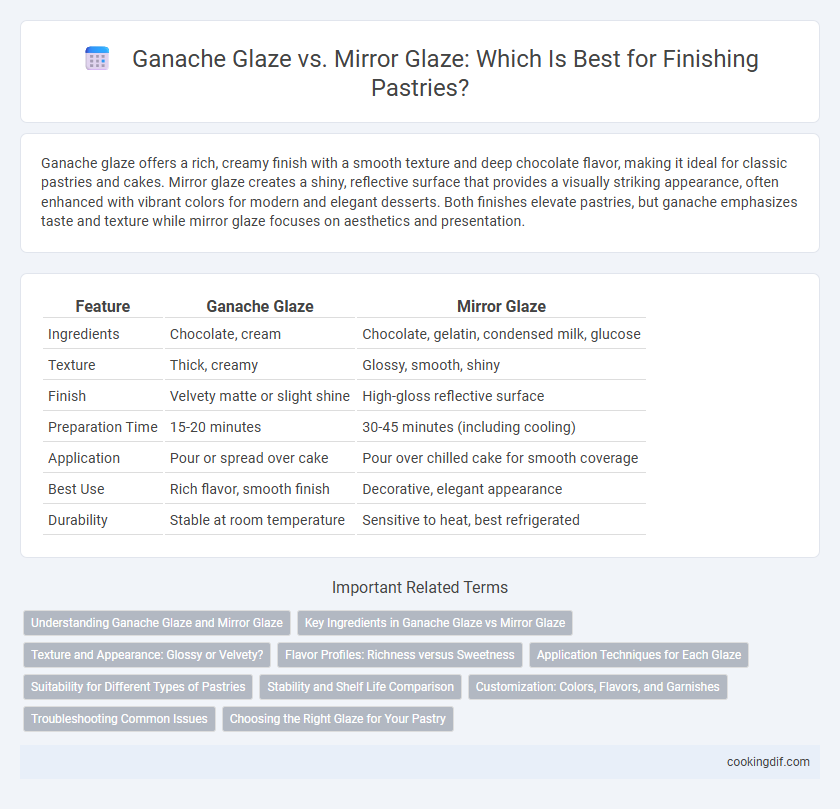Ganache glaze offers a rich, creamy finish with a smooth texture and deep chocolate flavor, making it ideal for classic pastries and cakes. Mirror glaze creates a shiny, reflective surface that provides a visually striking appearance, often enhanced with vibrant colors for modern and elegant desserts. Both finishes elevate pastries, but ganache emphasizes taste and texture while mirror glaze focuses on aesthetics and presentation.
Table of Comparison
| Feature | Ganache Glaze | Mirror Glaze |
|---|---|---|
| Ingredients | Chocolate, cream | Chocolate, gelatin, condensed milk, glucose |
| Texture | Thick, creamy | Glossy, smooth, shiny |
| Finish | Velvety matte or slight shine | High-gloss reflective surface |
| Preparation Time | 15-20 minutes | 30-45 minutes (including cooling) |
| Application | Pour or spread over cake | Pour over chilled cake for smooth coverage |
| Best Use | Rich flavor, smooth finish | Decorative, elegant appearance |
| Durability | Stable at room temperature | Sensitive to heat, best refrigerated |
Understanding Ganache Glaze and Mirror Glaze
Ganache glaze, made from a simple blend of chocolate and cream, offers a rich, glossy finish that enhances the flavor and texture of pastries with a velvety smooth surface. Mirror glaze, typically composed of gelatin, cocoa, sugar, and condensed milk, creates a highly reflective, glass-like coating ideal for modern pastries and entremets. Choosing between ganache and mirror glaze depends on desired visual impact and texture, with ganache providing depth and creaminess and mirror glaze delivering striking aesthetics and a delicate bite.
Key Ingredients in Ganache Glaze vs Mirror Glaze
Ganache glaze primarily consists of chocolate and heavy cream, creating a rich and smooth finish with a glossy sheen perfect for a natural chocolate flavor. Mirror glaze combines sweetened condensed milk, gelatin, and white chocolate, producing a highly reflective, glass-like surface that can be colored and customized for an artistic finish. The gelatin content in mirror glaze allows it to set firmly and provide a striking visual appeal, whereas ganache offers a softer texture and deep chocolate intensity.
Texture and Appearance: Glossy or Velvety?
Ganache glaze offers a velvety, smooth texture with a rich, matte finish that enhances the luxurious mouthfeel of pastries. Mirror glaze provides an exceptionally glossy, reflective surface that creates a visually stunning, glass-like appearance, perfect for modern, elegant desserts. The choice between ganache and mirror glaze ultimately depends on whether a soft, indulgent texture or a striking, high-shine finish is desired for the pastry.
Flavor Profiles: Richness versus Sweetness
Ganache glaze offers a rich, intense chocolate flavor with a smooth, velvety texture that enhances the depth of pastries. Mirror glaze provides a sweeter, lighter taste with a glossy, visually striking finish that balances sweetness without overwhelming the dessert's core flavors. Choosing between ganache and mirror glaze depends on whether a pastry requires bold richness or a bright, sugary contrast.
Application Techniques for Each Glaze
Ganache glaze requires careful temperature control and a slightly warm consistency to achieve a smooth, glossy finish when poured over cakes, ensuring it adheres evenly without dripping off. Mirror glaze involves a precise preparation with gelatin and a temperature range between 90-95degF to create a reflective, glass-like surface, generally poured while the cake is chilled to set instantly. Both techniques demand swift application and controlled pouring to avoid imperfections and maximize visual appeal.
Suitability for Different Types of Pastries
Ganache glaze offers a rich, creamy texture ideal for cakes, tarts, and pastries that benefit from a dense, chocolatey finish, enhancing flavors like vanilla, coffee, and fruit. Mirror glaze provides a glossy, reflective surface best suited for mousse cakes and entremets, delivering a visually striking finish that highlights intricate shapes and vibrant colors. Pastry chefs often select ganache for rustic, traditional desserts while choosing mirror glaze for modern, elegant presentations.
Stability and Shelf Life Comparison
Ganache glaze offers superior stability due to its cocoa butter and cream base, making it less prone to separation and ideal for longer shelf life compared to mirror glaze. Mirror glaze, primarily made from gelatin, sugar, and condensed milk, provides a glossy finish but is more sensitive to temperature changes, reducing its storage duration. For pastries requiring extended freshness and consistent texture, ganache glaze is preferred over mirror glaze.
Customization: Colors, Flavors, and Garnishes
Ganache glaze offers versatile customization with its rich, creamy texture allowing easy incorporation of various flavors such as chocolate, coffee, or fruit essences, while also supporting natural color variations from cocoa or added food dyes. Mirror glaze provides a glossy, reflective finish that can be customized with vibrant colors through gelatin-based mixtures and edible pigments, enabling intricate marbling and gradient effects. Both glazes accommodate diverse garnishes like fresh fruits, edible flowers, or textured nuts to enhance visual appeal and taste complexity.
Troubleshooting Common Issues
Ganache glaze often faces issues such as streakiness or dullness due to improper chocolate-to-cream ratios or insufficient cooling before application, which can be resolved by adjusting ingredient proportions and ensuring the glaze reaches the correct pouring temperature between 90-95degF (32-35degC). Mirror glaze problems commonly include bubbles, cracking, or cloudiness caused by incorrect gelatin blooming, overmixing, or applying at wrong temperatures; troubleshooting involves precise gelatin measurement, gentle stirring to avoid air incorporation, and pouring the glaze at 89-90degF (31-32degC) for optimal shine. Both finishes require careful temperature control and ingredient balance to achieve a smooth, glossy, and flawless appearance on pastries.
Choosing the Right Glaze for Your Pastry
Ganache glaze offers a rich, creamy texture with a deep chocolate flavor ideal for classic pastries, while mirror glaze provides an eye-catching, glossy finish perfect for modern, visually stunning desserts. Choosing the right glaze depends on the desired visual impact and flavor profile; ganache enhances taste and texture, whereas mirror glaze prioritizes presentation with its reflective surface. Consider factors like pastry type, occasion, and ingredient compatibility to achieve the perfect balance between taste and aesthetics.
Ganache glaze vs mirror glaze for finish Infographic

 cookingdif.com
cookingdif.com